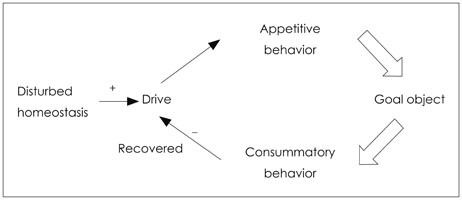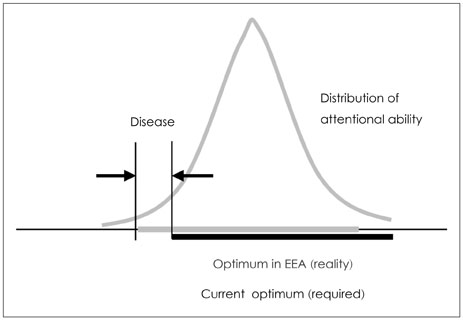J Korean Neuropsychiatr Assoc.
2018 May;57(2):173-189. 10.4306/jknpa.2018.57.2.173.
Evolutionary Psychiatry II-Mental Functions and Diseases from the Evolutionary Perspective
- Affiliations
-
- 1Department of Neuropsychiatry, Seoul National University Hospital, Seoul, Korea. kangug@snu.ac.kr
- 2Department of Psychiatry and Behavioral Science, Seoul National University College of Medicine, Seoul, Korea.
- 3Clinical Research Institute, Seoul National University Hospital, Seoul, Korea.
- KMID: 2419264
- DOI: http://doi.org/10.4306/jknpa.2018.57.2.173
Abstract
- Previously (Part I) the authors introduced the evolutionary biology and psychology. In the present part (Part II) of the review article, we discuss what disease is, and how diseases are explained in terms of the evolutionary perspective. Various psychologic phenomena and psychopathologic conditions are also illuminated under this evolutionary light. Through this approach, the authors hope that clinicians would search for the "normality" as well as pathology in patients, and would utilize this insight to understand and treat them accordingly.
Keyword
MeSH Terms
Figure
Reference
-
1. Paek MJ, Kang UG. [Phenomenological Psychopathology]. J Korean Neuropsychiatr Assoc. 2011; 50:97–115.2. American Psychiatric Association. Diagnostic and statistical manual of mental disorders, 5th edition: DSM-5. Arlington: American Psychiatric Publishing;2013.3. MacLean PD. Evolutionary psychiatry and the triune brain. Psychol Med. 1985; 15:219–221.
Article4. Dennett DC. Consciousness explained. New York: Little Brown & Co;1991.5. Park S, Kang UG. What is addiction? Pathophysiology and therapeutic implications (I). J Korean Acad Addict Psychiatry. 2014; 18:3–16.6. Commissaris RL. Conflict behaviors as animal models for the study of anxiety. In : van Haaren F, editor. Methods in behavioral pharmacology. Amsterdam: Elsevier;1993. p. 443–474.7. Beck AT, Alford BA. Depression: causes and treatment. 2nd ed. Philadelphia: University of Pennsylvania Press;2009.8. Freud S. Das Unbehagen in der Kultur. Wien: Internationaler Psychoanalytischer Verlag;1930.9. Weisfeld GE, Czilli T, Phillips KA, Gall JA, Lichtman CM. Possible olfaction-based mechanisms in human kin recognition and inbreeding avoidance. J Exp Child Psychol. 2003; 85:279–295.
Article10. Hamilton WD. The genetical evolution of social behaviour. I. J Theor Biol. 1964; 7:1–16.
Article11. Boyd R, Richerson PJ. Cultural transmission and the evolution of cooperative behavior. Hum Ecol. 1982; 10:325–351.
Article12. Hobbes T. Leviathan or the matter, forme and power of a common wealth ecclesiastical and civil. Oxford: Blackwell;1651.13. Stevens A, Price J. Evolutionary psychiatry: a new beginning. 2nd ed. London: Routledge;2000.14. Chance MRA, Jolly C. Social groups of monkeys, apes and men. New York: Dutton;1970.15. Cannon WB. Bodily changes in pain, hunger, fear, and rage: an account into the function of emotional excitement. 2nd ed. New York: D. Appleton and Company;1929.16. Goffman E. Stigma: notes on the management of spoiled identity. Englewood Cliffs: Prentice Hall;1963.17. Musto DF. Quarantine and the problem of AIDS. Milbank Q. 1986; 64:97–117.
Article18. Flannelly KJ, Koenig HG, Galek K, Ellison CG. Beliefs, mental health, and evolutionary threat assessment systems in the brain. J Nerv Ment Dis. 2007; 195:996–1003.
Article19. Kurzban R, Leary MR. Evolutionary origins of stigmatization: the functions of social exclusion. Psychol Bull. 2001; 127:187–208.
Article20. Baumeister RF, Leary MR. The need to belong: desire for interpersonal attachments as a fundamental human motivation. Psychol Bull. 1995; 117:497–529.
Article21. Sidanius J, Pratto F. Social dominance: an intergroup theory of social hierarchy and oppression. New York: Cambridge University Press;1999.22. Kang U, Kim H. [A historical consideration of psychiatric diagnostic systems : focusing on the concept of depression]. J Korean Neuropsychiatr Assoc. 2014; 53:259–292.
Article23. de Jong JW, Vanderschuren LJ, Adan RA. Towards an animal model of food addiction. Obes Facts. 2012; 5:180–195.
Article24. de Jong JW, Meijboom KE, Vanderschuren LJ, Adan RA. Low control over palatable food intake in rats is associated with habitual behavior and relapse vulnerability: individual differences. PLoS One. 2013; 8:e74645.
Article25. van der Leer L, McKay R. “Jumping to conclusions” in delusion-prone participants: an experimental economics approach. Cogn Neuropsychiatry. 2014; 19:257–267.
Article26. Maher BA. Delusional thinking and perceptual disorder. J Individ Psychol. 1974; 30:98–113.27. Park JS, Kang UG. How delusion is formed? Med Hypotheses. 2016; 87:61–65.
Article28. Berridge KC, Robinson TE. What is the role of dopamine in reward: hedonic impact, reward learning or incentive salience? Brain Res Brain Res Rev. 1998; 28:309–369.
Article29. Kalivas PW, Stewart J. Dopamine transmission in the initiation and expression of drug- and stress-induced sensitization of motor activity. Brain Res Brain Res Rev. 1991; 16:223–244.
Article30. American Psychiatric Association. Diagnostic and statistical manual of mental disorders. 3rd ed. Washington D.C.: American Psychiatric Association;1980.31. Stone VE, Cosmides L, Tooby J, Kroll N, Knight RT. Selective impairment of reasoning about social exchange in a patient with bilateral limbic system damage. Proc Natl Acad Sci U S A. 2002; 99:11531–11536.
Article32. Pani L. Is there an evolutionary mismatch between the normal physiology of the human dopaminergic system and current environmental conditions in industrialized countries? Mol Psychiatry. 2000; 5:467–475.
Article33. Schneider K. Klinische psychopathologie. 14th ed. Stuttgart: Thieme Georg Verlag;1992.34. Cosmides L, Tooby J. Cognitive adaptations for social exchange. In : Barkow JH, Cosmides L, Tooby J, editors. The adapted mind: evolutionary psychology and the generation of culture. . New York: Oxford University Press;1992.35. Wilkinson S, Fernyhough C. Auditory verbal hallucinations and inner speech: a predictive processing perspective. In : Radman Z, editor. Before consciousness: in search of the fundamentals of mind. 1st ed. Exeter: Imprint Academic;2017.36. Plaze M, Mangin JF, Paillère-Martinot ML, Artiges E, Olié JP, Krebs MO, et al. “Who is talking to me?” - Self-other attribution of auditory hallucinations and sulcation of the right temporoparietal junction. Schizophr Res. 2015; 169:95–100.
Article37. Swiney L, Sousa P. A new comparator account of auditory verbal hallucinations: how motor prediction can plausibly contribute to the sense of agency for inner speech. Front Hum Neurosci. 2014; 8:675.
Article38. Ford JM. Studying auditory verbal hallucinations using the RDoC framework. Psychophysiology. 2016; 53:298–304.
Article39. Kang UG. [Understanding the dopaminergic system and the action of antipsychotics]. J Korean Neuropsychiatr Assoc. 2011; 50:251–272.40. Park SY, Kang UG. Hypothetical dopamine dynamics in mania and psychosis--its pharmacokinetic implications. Prog Neuropsychopharmacol Biol Psychiatry. 2013; 43:89–95.
Article41. Ricciardiello L, Fornaro P. Beyond the cliff of creativity: a novel key to Bipolar Disorder and creativity. Med Hypotheses. 2013; 80:534–543.42. Geoffroy PA, Bellivier F, Scott J, Etain B. Seasonality and bipolar disorder: a systematic review, from admission rates to seasonality of symptoms. J Affect Disord. 2014; 168:210–223.
Article43. Perugi G, Fornaro M, Akiskal HS. Are atypical depression, borderline personality disorder and bipolar II disorder overlapping manifestations of a common cyclothymic diathesis? World Psychiatry. 2011; 10:45–51.
Article44. Andreasen NC, Grove WM. Thought, language, and communication in schizophrenia: diagnosis and prognosis. Schizophr Bull. 1986; 12:348–359.
Article45. American Psychiatric Association. Diagnostic and statistical manual of mental disorders. 2nd ed. Washington D.C.: American Psychiatric Publishing;1968.46. Selye H. Stress and distress. Compr Ther. 1975; 1:9–13.47. Thierry B, Steru L, Chermat R, Simon P. Searching-waiting strategy: a candidate for an evolutionary model of depression? Behav Neural Biol. 1984; 41:180–189.
Article48. Badcock PB, Davey CG, Whittle S, Allen NB, Friston KJ. The depressed brain: An evolutionary systems theory. Trends Cogn Sci. 2017; 21:182–194.
Article49. Nesse RM, Williams GC. Why we get sick. New York: Random House;1994.50. Allen NB, Badcock PB. Darwinian models of depression: a review of evolutionary accounts of mood and mood disorders. Prog Neuropsychopharmacol Biol Psychiatry. 2006; 30:815–826.
Article51. Durisko Z, Mulsant BH, Andrews PW. An adaptationist perspective on the etiology of depression. J Affect Disord. 2015; 172:315–323.
Article52. Raison CL, Miller AH. Pathogen-host defense in the evolution of depression: insights into epidemiology, genetics, bioregional differences and female preponderance. Neuropsychopharmacology. 2017; 42:5–27.
Article53. Anders S, Tanaka M, Kinney DK. Depression as an evolutionary strategy for defense against infection. Brain Behav Immun. 2013; 31:9–22.
Article54. Tanaka M, Kinney DK. An evolutionary hypothesis of suicide: why it could be biologically adaptive and is so prevalent in certain occupations. Psychol Rep. 2011; 108:977–992.
Article55. Shah A, Bhat R, Zarate-Escudero S, DeLeo D, Erlangsen A. Suicide rates in five-year age-bands after the age of 60 years: the international landscape. Aging Ment Health. 2016; 20:131–138.
Article56. Van Orden KA, Simning A, Conwell Y, Skoog I, Waern M. Characteristics and comorbid symptoms of older adults reporting death ideation. Am J Geriatr Psychiatry. 2013; 21:803–810.
Article57. de Catanzaro D. Reproductive status, family interactions, and suicidal ideation: surveys of the general public and high-risk groups. Ethol Sociobiol. 1995; 16:385–394.
Article58. Curzon P, Rustay NR, Browman KE. Chapter 2. Cued and contextual fear conditioning for rodents. In : Buccafusco JJ, editor. Methods of behavior analysis in neuroscience. 2nd ed. Boca Raton: CRC Press;2009.59. Cunningham CL. Pavlovian drug conditioning. In : van Haaren F, editor. Methods in behavioral pharmacology. Amsterdam: Elsevier Science;1993. p. 349–381.60. Baldwin DV. Primitive mechanisms of trauma response: an evolutionary perspective on trauma-related disorders. Neurosci Biobehav Rev. 2013; 37:1549–1566.
Article61. McGregor IS, Hargreaves GA, Apfelbach R, Hunt GE. Neural correlates of cat odor-induced anxiety in rats: region-specific effects of the benzodiazepine midazolam. J Neurosci. 2004; 24:4134–4144.
Article62. Bracha HS. Human brain evolution and the “neuroevolutionary timedepth principle:” Implications for the reclassification of fear-circuitry-related traits in DSM-V and for studying resilience to warzone-related posttraumatic stress disorder. Prog Neuropsychopharmacol Biol Psychiatry. 2006; 30:827–853.
Article63. Brüne M. The evolutionary psychology of obsessive-compulsive disorder: the role of cognitive metarepresentation. Perspect Biol Med. 2006; 49:317–329.
Article64. Lange KW, Reichl S, Lange KM, Tucha L, Tucha O. The history of attention deficit hyperactivity disorder. Atten Defic Hyperact Disord. 2010; 2:241–255.
Article65. Barkley RA. Attention deficit hyperactivity disorder: A handbook for diagnosis and treatment. 3rd ed. New York: Guilford Press;2005.66. Watanabe M, Kodama T, Hikosaka K. Increase of extracellular dopamine in primate prefrontal cortex during a working memory task. J Neurophysiol. 1997; 78:2795–2798.
Article67. Murphy BL, Arnsten AF, Goldman-Rakic PS, Roth RH. Increased dopamine turnover in the prefrontal cortex impairs spatial working memory performance in rats and monkeys. Proc Natl Acad Sci U S A. 1996; 93:1325–1329.
Article68. Archibald SJ, Mateer CA, Kerns KA. Utilization behavior: clinical manifestations and neurological mechanisms. Neuropsychol Rev. 2001; 11:117–130.69. Park JS, Kang UG. [History of Schizophrenia]. J Korean Neuropsychiatr Assoc. 2015; 54:365–398.
Article70. Lombardo GP, Foschi R. The concept of personality in 19th-century French and 20th-century American psychology. Hist Psychol. 2003; 6:123–142.
Article71. Zachar P, Krueger RF. Chapter 52. Personality disorder and validity: a history of controversy. In : Fulford KWM, Davies M, Gipps R, Graham G, Sadler J, Stanghellini G, editors. The Oxford handbook of philosophy and psychiatry. Oxford: Oxford University Press;2013.72. Boyd R, Richerson PJ. Punishment allows the evolution of cooperation (or anything else) in sizable groups. Ethol Sociobiol. 1992; 13:171–195.
Article73. Ermer E, Guerin SA, Cosmides L, Tooby J, Miller MB. Theory of mind broad and narrow: reasoning about social exchange engages ToM areas, precautionary reasoning does not. Soc Neurosci. 2006; 1:196–219.
Article74. Premack D, Woodruff G. Does the chimpanzee have a theory of mind? Behav Brain Sci. 1978; 4:515–526.
Article75. Ploeger A, Galis F. Evolutionary approaches to autism- an overview and integration. Mcgill J Med. 2011; 13:38.
Article76. Porges SW. The polyvagal theory: phylogenetic contributions to social behavior. Physiol Behav. 2003; 79:503–513.
Article77. Charland LC. Chapter 13. Why psychiatry should fear medicalization. In : Fulford B, Davies M, Gipps R, Graham G, Sadler J, Stanghellini G, editors. The Oxford handbook of philosophy and psychiatry. Oxford: Oxford University Press;2013.78. Sadler JZ. Value and psychiatric diagnosis. Oxford: Oxford University Press;2003.79. Elton A, Smith CT, Parrish MH, Boettiger CA. Neural systems underlying individual differences in intertemporal decision-making. J Cogn Neurosci. 2017; 29:467–479.
Article80. Foddy B, Kahane G, Savulescu J. Chapter 69. Practical neuropsychiatric ethics. In : Fulford B, Davies M, Gipps R, Graham G, Sadler J, Stanghellini G, editors. The Oxford handbook of philosophy and psychiatry. Oxford: Oxford University Press;2013.
- Full Text Links
- Actions
-
Cited
- CITED
-
- Close
- Share
- Similar articles
-
- Research Methodologies of Evolutionary Psychiatry
- Evolutionary Approaches toward Psychiatry
- Evolutionary Psychiatry I-Concept of Evolutionary Psychology and Evolutionary Psychopathology
- Evolutionary Hypotheses of Mental Disorder and Their Limitations
- The Evolutionary Psychological Aspects of Anxiety and Anxiety Disorders



